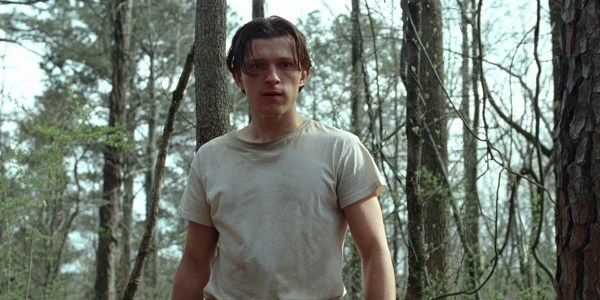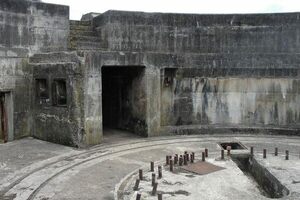Cycles of Violence, Catharsis, and THE DEVIL ALL THE TIME
Lamech said to his wives: “Adah and Zillah, hear my voice; You wives of Lamech, listen to what I say: I have killed a man for wounding me, a young man for striking me. If Cain is avenged sevenfold, truly Lamech seventy-sevenfold.” (Genesis 4:23-24, NRSV)
After Cain killed his brother, he feared that someone would kill him in return for his evil act. God exiled Cain to wander the land for his crime and ended the cycle of violence by marking Cain so that no one would kill him without fear of divine vengeance. Despite the mark on Cain, the reader finds that a few generations beyond Cain still suffered from an unending cycle of violence. Lamech, one of Cain’s descendants, justifies the slaying of a young man by claiming that he was injured first, yet the fear of retaliation from one of the youth’s friends or family members remains, leading to the above proclamation to his wives.
The story of Cain and his descendants is the story of enmity between brothers and the ways in which we justify our violent actions against fellow humans. It is the story of the spiraling and equally violent effects of those actions when they are returned to us. Antonio Campos’s The Devil All the Time feels like it was pulled from Genesis. The narrative follows two generations of people and the seeming inescapable violence of their lives. Each act of violence has a reverberating effect that pushes the narrative forward and leaves the audience wondering what is the purpose of the violence and how does the cycle end.
The Devil All the Time is disturbing and unrelenting in its portrayal of the cycles of violence. From a World War II veteran’s attempts to bargain with God through ritual violence to the chaotic evil of a serial killer and his wife who live out their violent sexual fantasies, the film both repulses the audience with fear of the possibility of evil yet attracts the audience with feelings of empathy, justice, and satisfaction. Each vignette of the film challenges the audience to reconsider their notions of just and unjust acts of violence and demonstrates that each act of violence, whether justified or not, warps and disfigures the human who commits them.
Cycles of Violence…
In The Devil All the Time, each character attempts to justify his acts of violence and the audience has to wrestle with the justifications. The first act of violence we see in the film is from Willard Russell (Bill Skarsgård), who, as a U.S. Marine in World War II, stumbles upon a fellow soldier who has been tortured and hung upon a cross. When they discover that the soldier is still alive, Willard holds a pistol up to the soldier’s temple and squeezes the trigger. Willard never comments on the action, but the action is portrayed as an act of mercy. The ethics or morality of the action is buried under the gray fog of war and the audience, though they may not approve of the action, empathizes with the impossible decisions and moral morass that soldiers must face in a time of war.
After the war, Willard struggles with PTSD from his experiences of violence in the war and is particularly haunted by the image of the soldier on the cross, which is also an image that is essential to his and his family’s religious beliefs. The opening of the film and the beginning of Willard’s story provide the framework in which violence functions in the film. First, it establishes that one is thrown into a violent world and the violent acts of one are usually preceded by witnessing or experiencing violent acts of others. Second, it establishes that violence even when it is perceived as justified, like fighting for one’s country after the country was attacked, damages the individual who commits acts of violence.

Since this is a film about cycles of violence continuing through generations, the side effects of the violence on the next generation are quickly established. Willard, after the war, returns home settles down with a woman that he loves, yet he cannot escape his history of violence in the war or his need to continue to commit acts of violence for various reasons after the war. The film shows that the young man who was altered by the violence of war passes on the destructive nature of his violent life to his son, Arvin (Tom Holland), through a system that justifies the violence.
And Human Justifications
Willard justifies his acts of violence two ways after the war: he connects his violent acts to the ethos of honor and the defense of his home, particularly his wife, and to religious ritual. The first scene of violence Willard commits after the war is when he retaliates against two poachers who he overhears contemplating sneaking down to his house and sexually assaulting his wife while he is away. Arvin, who overhears them talk about his mother, wants to act automatically, but his father tells him to wait for the right time. Later, Willard takes his son along for a ride where he nearly beats both men to death in a strategic attack.
After the attack, Willard tells Arvin, who has been troubled by bullies, that he expects him to do the same to the bullies that have been bothering him. He contextualizes and justifies his actions by saying, “There’s a lot of no good sons of bitches out there,” implying that the only way to deal with those who are no good is to act violently against them. Arvin takes his father’s advice to heart and remembers that day “as the best one he ever spent with his father.”
When the film jumps ahead to Arvin as a young adult, the patterns of violence established by his father are emphasized in two scenes. First, he receives the luger that his father brought home from the war for his birthday. The same luger will provide the tool for Arvin to purify his community of those who are up to no good in the future, which establishes the luger as a symbol of both violence and the justifications that his father has passed down to him.
The second scene that establishes the continuation of the cycle of violence through Arvin is when he notices that his younger adopted sister Lenora (Eliza Scanlon) is being sexually harassed by three of her high school classmates. Arvin, like his father, plans an attack where the three are separated, and he is able to beat each of them nearly to death. The mirroring of the attacks shows that Arvin is not only his father’s son, but the violence of his father has been passed down to him along with the same justifications: he was defending his sister and her honor.
Empathy and the Audience
In an era when powerful men have just recently started to come to justice for their years of sexual assaults without punishment or exclusion, the mirrored beatings of the poachers and the teenage boys provide satisfaction for the audience because there is a feeling of justice in the actions. As Arvin’s pursuit of justice intensifies into more violent actions against worse offenders, both Arvin and the audience feel the need to justify the violence. For the audience, the violence can feel satisfying because justice has been reduced to a visceral action that some primal part of us desires.

Justice has returned to an eye for an eye and a tooth for a tooth within the narrative of The Devil All the Time, and Arvin’s four murders at the end of the film seem not only perfectly justifiable but also there is a pleasure to the deaths of the people he kills. No one mourns the slaying of the minister who he kills first. The minister is a pedophile who not only pushed Lenore to accidental suicide when she discovered that she was pregnant with his child but also was preying on another girl in the church that appeared to be younger than Arvin’s sister.
The audience empathizes with this act of vengeance and justice, but the film does not allow the audience to empathize with the act without being disturbed. The shooting is not stylized; instead, the loud firing of Arvin’s Luger stuns the audience as much as it stuns Arvin. We, like Arvin, are left with a view of the dead body, and the camera continually shows us Arvin from the perspective of the bloodied body. The camera does not allow us to look away from the damage that was done in the name of vengeance and justice, which allows the audience to distance itself from Arvin through fear of the ramifications of the action and the constant reminder of the corpse.
The next three murders, though they are not premeditated, follow the same pattern. When Arvin is picked up by the serial killer couple and recognizes the danger that he is in, the gunfire from his gun shocks and then the audience must reckon with the bloody bodies left behind. One does not mourn the passing of a couple that killed and photographed victims for a couple of decades. There is a sense of satisfaction and justice on the side of the audience, but the corpses remind us that the violence of justice is just as brutal and disturbing as the violence performed by those who were killed.
Arvin’s final act of violence is the killing of Sheriff Lee Bodecker (Sebastian Stan), who is a crooked cop who has been taking bribes and covering up for his sister and her husband who were the serial killers that Arvin killed. In the final act of the film, Sheriff Bodecker uses violence to protect his position of power. He kills the gangsters that have been paying him off to cover up for the bribes that he has taken, and he attempts to hunt down and kill Arvin before he can be apprehended and produce evidence against his sister and brother-in-law, which would be used against him in the coming election. When Arvin kills Bodecker, we empathize with his situation because it is in self-defense and we know that the corruption of Bodecker has prevented actual justice in the town for decades, yet Arvin’s fate once all the monsters are dead in the film is not one of a victorious hero.
Exile of the Tragic Hero and Catharsis
The Devil All the Time is not a revenge narrative that allows the audience to accept violence as a form of pure justice. One cannot leave the film without being disturbed by the violence even if we approve of the fate of the people that it is visited upon. In this sense, the film falls into Aristotle’s category of tragedy, especially when focused on the character of Arvin, and the effect of the film is a type of catharsis.
According to Aristotle, tragedy is supposed to arouse the emotions of “pity and fear, wherewith to accomplish its catharsis of such emotions” (Poetics 1449b.24-28). Though the term “catharsis” in Aristotle is still debated, many have interpreted the term as a contradiction to Plato’s fear that mimesis and the emotions evoked by art would drive audiences into an emotional frenzy that would override their rational control. The pity and fear aroused by tragedy, as described by Aristotle, is not meant to overwhelm audiences but to distance them from these emotions so that they can encounter them with reason.

The horror of the violence in The Devil All the Time counters the empathy or pity that we would normally feel in this type of narrative and challenges us to re-examine how emotions manipulate our notions of justice and how the violence that we enact in pursuit of justice damages our own souls and psyches. Arvin becomes the exemplar of one who is destroyed by acts of violence that are supposed to purify the community from evil, and his destruction is on full display as he leaves town at the end, exiled like the tragic hero that he is.
Arvin, as he rides away from home, wonders what he will do next, and he considers joining the Army and going to Vietnam because he is good at fighting and he cannot return home. Arvin’s life has been so shaped by violence that his whole self-conception has been altered to one who is good at fighting. The justifications that drove the violent acts up to this point have disappeared, and he sees himself as an agent of violence rather than an agent of justice. The film ends without letting the audience know Arvin’s future, but if he does end up in Vietnam, it is not for country or justice that he fights but because he imagines that he is only capable of success as a violent individual.
Conclusion
Like Oedipus and Cain, Arvin is marked by his violence and exiled from his community. Even though Arvin purified the community of predators, by adopting the violence of predators, he has become his own type of predator and the cycle of violence that started with his father continues in him as he contemplates entering another war. Just as the narratives of Cain and Lamech ask, “How does one end the cycle of violence,” The Devil All the Time forces the audience to ask not only “When will the cycle of violence end” but “How can we execute justice against those who do evil without destroying our own souls?”
Watch The Devil All the Time
References
Aristotle. Poetics. The Basic Works of Aristotle, trans. Ingram Bywater, The Modern Library, 2001, p. 1455-87.
Genesis. The New Oxford Annotated Bible, Ed. Michael D. Coogan, NRSV, 4th ed., Oxford UP, 2010, 11-80.
Does content like this matter to you?
Become a Member and support film journalism. Unlock access to all of Film Inquiry`s great articles. Join a community of like-minded readers who are passionate about cinema – get access to our private members Network, give back to independent filmmakers, and more.
Join now!





